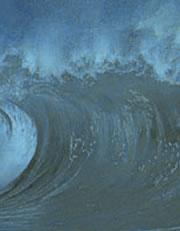 The Discovery weathered waves 29 metres high.© Getty
The Discovery weathered waves 29 metres high.© GettyOn the dark and stormy night of 8 February 2000, you wouldn't want to have been on board the Discovery, a British oceanographic research ship.
Out in the North Atlantic, 250 km west of Scotland and close to the tiny island of Rockall, the ship was forced to sit through what researchers think are the biggest waves ever directly recorded in the open ocean. The two largest measured just over 29 metres from peak to trough — about the height of a ten-storey building.
The tempest, which hit its peak close to midnight, was terrifying for the scientists on board. "It was pretty horrendous," says oceanographer Naomi Holliday of the University of Southampton in England, who was on the Discovery. "Nobody got any sleep — we were literally thrown out of our bunks." But the ordeal may have an important scientific payoff in showing that such extreme ocean conditions could be more common in this area than previously recognized, say Holliday and colleagues in a paper in Geophysical Research Letters1.
“We were literally thrown out of our bunks.”
Naomi Holliday,
University of Southampton, UK
Marine engineers are keen to know what the ocean is likely to throw at them. Ships can usually steer clear of big storms, but offshore oil rigs and exploration platforms would have to be capable of withstanding them. Ships and oil rigs are typically designed on the assumption that they will face waves no bigger than around 15 metres.
A computer weather model used by Holliday's team was able to predict the high seas of 8 February. But it underestimated the height of the waves, they write.
Freak waves
Gigantic 'freak waves' have been recorded anecdotally in the past, and have been blamed for the mysterious disappearances of ships at sea. In March 2001 the Caledonian Star passenger ship was hit by a wave in the South Atlantic estimated to be around 30 m high, which smashed over the vessel and almost sank it. The QE2 is also said to have met such giants in the North Atlantic in 1995.
“We were literally thrown out of our bunks.”
Naomi Holliday,
University of Southampton, UK
But these so-called rogue waves are thought to be rare anomalies. The monstrous waves measured by Holliday and her colleagues on the Discovery, on the other hand, do not seem to have been lone freaks — they were representative of the storm as a whole, which generated waves typically more than 18 m high.
The Rockall region is known for its rough seas, the researchers say — a 26-m wave was recorded there in 1972. "Very strong winds are common here all the year round," says Holliday.
She and her colleagues think that the extreme conditions in 2000 were caused by a resonance effect, when the high wind speed happened to match the speed of the waves. This meant that "the wind was continually putting energy into the sea", says Holliday — like a person running behind another runner and pushing him along. The researchers suspect that other such cases of resonant wave growth may have gone unrecorded in this area.
Measuring stick
Higher waves can be whipped up during extreme events such as hurricanes. Waves around 30 m high are thought to have occurred in the Gulf of Mexico during Hurricane Ivan in 2004, for example.
But no one was out and about measuring those waves in a boat. Instead, wave heights were estimated based on measurements of water pressure made by sensors on the sea floor2.
ADVERTISEMENT
The monsters seen by Holliday and colleagues may be the largest observed directly from shipboard measurements. The ship itself acted as the measuring device: onboard instruments that measure the vessel's acceleration and the pressure exerted on it were used to determine the size of the waves throwing it around.
Visit our enduresrecordbreaking_wa.html">newsblog to read and post comments about this story.
University of Southampton, UK
